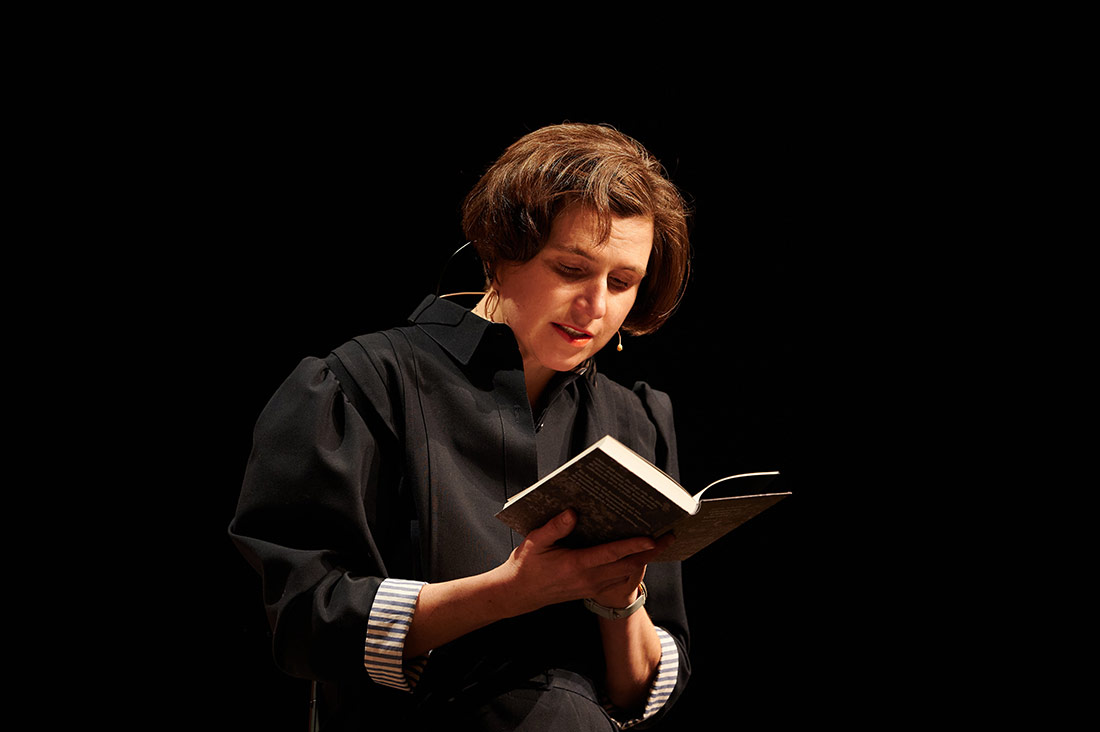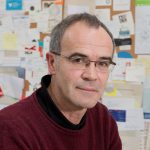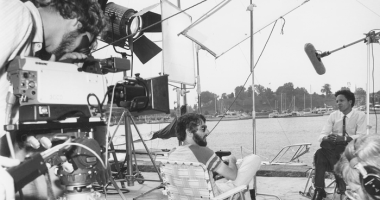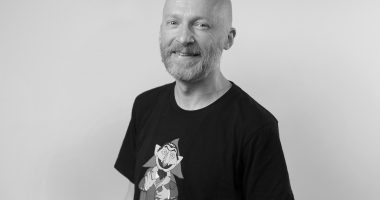Books such as Atlas of Remote Islands and An Inventory of Losses have made Judith Schalansky a unique name in the world of literature. Taking advantage of her visit to the CCCB, we talk to her about her work, which invites readers to travel through a universe where gender, reality and fiction intertwine.
The echoes of Judith Schalansky’s writing are innumerable. Her work reverberates with Jorge Luis Borges, Italo Calvino, Safo, Raymond Roussel, Natalie Clifford Barney, Marcel Schwob, W. G. Sebald, J. M. Coetzee, Iain Sinclair…; overlooked maps, forbidden manuscripts, anonymous reports, medieval codices, letters of hope and despair. It depends on each reader, on the way we allow ourselves to be nourished by books that are run through by accuracy, multiplicity and consistency. Artefacts written and designed to fight against oblivion, knowing that writing does not have the power to restore to us what no longer exists, but it does allow us to experience it.
Schalansky has created her own long-awaited voice that at the same time unfolds in one that is as plural as the universe. Schalansky’s writing explores ancestral labyrinths and forking paths, and oscillates between the sublime and the sinister, but breaks away from dualistic mirages. Each work created by this young German author is an enigmatic gift. In Atlas of Remote Islands (2009) we discover 50 stories inspired by historical events and scientific reports, but which Schalansky turns into unprecedented journeys in time and space on a planet that might also be called Ocean. The Giraffe’s Neck (2011), her following novel, is, among other possible readings, a caustic reflection on the influence and distortion of Darwinian theory. And in An Inventory of Losses (2018), her latest book published in Catalan and Spanish, Schalansky displays a power of expression that establishes her as a vital author to continue sensing the protean paths of the literature to come.
The Schalansky experiment enlightens readers, hyperactively stimulating one of the most extraordinary gifts of the human condition: that inexhaustible capacity that we call imagination, which never came to power but is essential in the creation of an anima mundi, a world soul, that no war, plague or catastrophe can extinguish.
The journey in the Atlas begins in the Berlin State Library, walking around a globe, imagining remote, idyllic places that are also home to the most godforsaken spots and to that which can be reborn. What was the first island you ever visited?
Probably, the first island in my life was Greifswalder Oie. It’s a small island, tiny, located opposite the island of Usedom. Usedom island is where my mother is from and also where my grandparents lived their whole lives. When I was little, I’d often go to the shore of the Baltic Sea and see that lighthouse in the distance. It was a place that represented longing. Naturally, that had to do with it being an inaccessible place, because Greifswalder Oie was in a prohibited area. The border was there and we were only allowed to swim as far as the buoys. In that sense, the image of the island on the horizon with its lighthouse always had something promising about it, even when I was little.
In The Story of More, Hope Jahren reminds us of the existence of a vast, fathomless sea called Panthalassa and an ocean of green slime that we call Tethys. The islands in your Atlas are situated according to the present-day division of the oceans, but some stories seem to be inhabited by a primordial spirit to remind us that this planet might also be called Ocean….
Of course. In fact, there’s a good reason it’s called the “blue planet”, or “blue marble” in English, which is nicer. The marble. And this marble concept makes me think of the unsettling vision the astronauts had, looking at something as it had never been seen before, discovering that backwards gaze. Suddenly, they saw that small planet, incredibly small and blue, surrounded by white clouds. I think that, until this day, that vision of the planet… gives us all the sensation that we are very fragile and fleeting. Not just us, as inhabitants of the planet, but also the planet itself. I think that, understandably so, the rediscovery of this planet as a blue planet has been decisive for the environmental protection movement. At the end of the day, it’s also an island, and in that sense, it’s an incredible exception in the known universe.

In Atlas you mention the island of Takuu in New Guinea with 560 inhabitants and end the text with a warning that it will sink in a month or in a year… Which of the islands in Atlas has already sunk or disappeared?
Actually, over the past year, I have gone back over the Atlas and looked at everything carefully. I’ve checked the population figures, I’ve looked into what’s happened since and I’ve written a new edition, with five new islands. And, of course, I had to rewrite the story of Takuu, because, actually, Takuu has not sunk. I find it fascinating, because I think we’re still in the process of finding a new narrative to explain the enormous changes in the environment and the destruction of the environment we’re seeing. We mustn’t forget that the image of a sunken island is very much embedded in our culture and is attractive to us. So, in the decade following the year 2000, the main narrative used to explain the climate crisis we were seeing was: all these Pacific islands will sink and we have to save these islands in order to save ourselves. All this, like so many things in life, is actually much more complex. In fact, what’s happening in Takuu is that the winds are much less reliable, so traditional fishing methods can’t be depended on in the same way as before. Now, the population depends more on contracts with others. But those people have been constantly experiencing the arrival of catastrophe tourism, as well as researchers, who, naturally… wanted to portray an image of an imminent sinking and, most recently, of the torrential rain they’d foretold, or that they’d predicted. I think that the Anthropocene teaches us that things are a lot more complicated. I’ve rewritten that story, which basically teaches us that humanity, even in these times of threat, develops new ideas. In fact, they’re already making an effort to hold onto that place, beyond this narrative that says everything will sink. They are our narratives. It’s the western point of view.
Your novel The Giraffe’s Neck can be interpreted as a singular, caustic reflection on Darwinian theory. Both in its popular version, where the law of the strongest prevails, and in the need for an education also present in Darwin—and in Kropotkin—that suggests a natural selection born of cooperation and mutual support between species, including the human species. Inge Lohmark, the central character in your novel, made me think of J.M. Coetzee’s Elisabeth Costello…
I agree with Borges, who said that every writer creates their precursors. I think that, funnily enough, books that you’ve never read can also inspire you. They are underground relationships that each person can create, like fungi spreading its mycelium networks. I find it very interesting anyway. I think that, in a big way, this book is about seeing which narrative we use to explain biological diversity. As far as Darwin’s law of survival of the fittest goes, at least in the German-speaking world, it’s a regrettable translation error. This shows how important translations are, because “the fittest” doesn’t mean “the strongest”, but rather the one who adapts the best. When we look at nature and see all the opulent beauty that has been created, that teaches us that the ornamental, or the beautiful, is also something that, in part, has its place and can survive.
In the prologue to An Inventory of Losses, you say that the world has become an immense archive of itself, a document that offers an almost infinite registry, where our taxonomies are an attempt to impose order on the formidable chaos of evolution and biodiversity. Everything leaves its mark. Is the Inventory an amplified continuation of the work begun in Atlas?
Yes, in fact, the Atlas, with the stories of the islands, has also stayed with me a lot, because it has been translated many times and had a wide reception. Originally, I wanted to write a second volume about ghost islands, until I realised that inexistent, invented islands are much less interesting than real ones. I’ve seen this constantly throughout my research. At the end of the day, reality is what’s most unsettling and original and our imagination is rarely up to scratch. I made the island of Tuanaki the protagonist of this story, because it existed and it sank. Again, I had the possibility to reflect on the problem of how we write about these islands and the perspective we have, in the sense that there are roles that are very clearly different: the so-called “indigenous peoples” and then us, the discoverers, who watch them from outside and make our own projection. Writing it was an adventure, because, again, I wrote it in the library and I wanted the library, as the real setting of the adventure, to exert its influence.
Each text in the Inventory suggests various ramifications, but in some, like “Caspian Tiger” and “Guericke’s Unicorn”, you explore the lineage of real and fantastic monsters. In the first through the liger, a creature that seems to be fantastic, but is in fact real, and in the second by means of a disturbing parable about the very nature of bestiaries… Should we love our monsters?
I think that’s a good idea. Perhaps, in order to love them… Maybe before loving them, we have to recognise them. I think that recognition is perhaps more important than love and we shouldn’t see it as something that we have to repress. At the end of the day… In fact, we have to understand them as part of the huge organism that makes up this world, this planet.
It’s terribly difficult to imagine that each and every one of us is connected and that, actually, we need the monsters. We shouldn’t forget that. We need them so that we don’t feel like monsters. In this sense, perhaps it’s about facing up to the monstrous side of human existence, of human beings, and integrating it… instead of projecting it onto the so-called “beasts”, who, of course, are not beasts, like predators. The biggest predator is us. But the problem is that we then feel guilty straight away and it seems too awful to us, which is understandable, but it’s not the solution. In this sense, I think we have to recognise these parts, in the psychoanalytical sense. Perhaps we should also mourn them and see how we deal with this ambivalence: the fact that we are capable of creating so much beauty and also appreciating it, while, at the same time, we take away the value of things, so that we can destroy them without feeling any remorse.
From the Baudelairian flâneur to the situationist dérive and the works of W. G. Sebald and Ian Sinclair, there exists a literary trend that connects lived experience, landscape and topos. For some critics, it could be defined as psychogeography. Have you felt yourself to be influenced by this genealogy?
I haven’t thought about psychogeography, nor read about the subject, but, now that you mention it, I can see that affinity. It is true that, for me, spaces are decisive and that, from these spaces, I try to develop my literature. In fact, I think that in spaces, we can find layers of the past that are still present. This type of relationship interests me even more as a narrative space than the private relationships between people that come later. In other words, at first, it’s crucial for me to consider where the story takes place, what space I’m moving through and how I make that space resonate, how I get it to explain something.
Your books are a fascinating mixture of erudition, precision and experimentation. As well as being a writer, you are a designer and an omnivorous reader. Could you describe your working methodology? What happens in Judith Schalansky’s laboratory?
The Schalansky laboratory can be found at Berlin’s State Library, where I’m lucky enough to be able to reserve a time slot, which we all have to do now, during which I can sit at an empty desk, because my desk at home is entirely submerged under biological layers of paper, half-written projects, manuscripts, etc. I’m… Right now, I’m still researching archaeology. Actually, I’ve discovered that each book I’ve written contains the nucleus of the following book. In some places, there are hidden references that I have to make legible. Since I discovered this, I look at my books differently and I try to find out where the next book is. I think the next book will be a short, romance novel. After this last, very dense book, I needed to do something light. And, of course, we know that the lightest is also the most difficult. In a certain way, I also look into historiography, because I’m very interested to what extent… basically how stories are written within a romantic relationship and how that has an enormous effect on what kind of love story we want to experience. I’m still interested in storytelling and, of course, the fact that love has to do with property, with submission and with rewriting. And the big question asks what the truth is, as well as the truth about love.
William Kwong Yu Yeung, from the Desert Eagle astronomical observatory in the United States, discovered an asteroid which he has named after you. What do you think about this peculiar honour?
It’s very important for me to point out that it never would have occurred to me to mention it, although, obviously, I am very proud of it. The Catalan publishing house included it in my biography. I doubt I’d have allowed it in the German edition, because it feels very presumptuous. In fact, I found out after the fact. An astronomy enthusiast, who’s discovered a load of asteroids, really enjoyed the book Atlas of Remote Islands, and so he gave it that name. I found it totally ironic, because in that book I say that an atlas belongs to the poetry genre and that it’s very human to leave our names and our mark on everything and to think… Perhaps we should consider navigators as failed poets, who never managed to write a poem to leave to posterity. And so, they chose another path: to take to the sea and plant their flag somewhere, that phallic ritual, and say: “I baptise you with my name”. We already know what really happened. Those places often already had a name, because other people lived there. As far as the asteroid goes, I’m not so sure, but who knows? Perhaps there’s a kind of… a kind of life form, or a kind of material that’s worth naming that there, was named long ago. They are our names. It’s not important to the asteroid. And that explains how everything… how this whole business is like a mirror in which all we can see is our desire for protagonism. Mine too, in this case, because when I found out, I thought: “Now I can die happy”.




Leave a comment